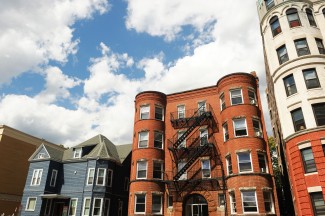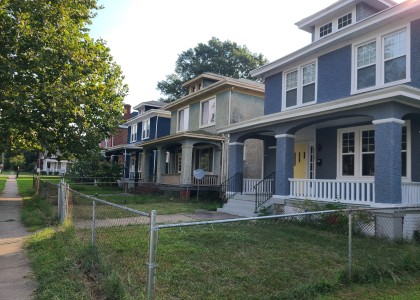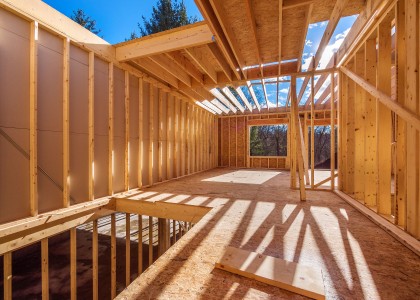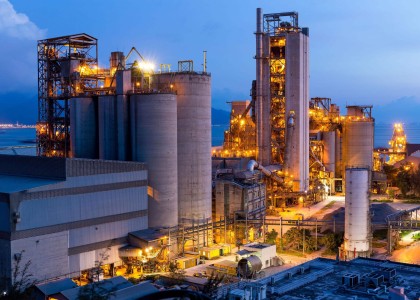Efficient electric water heaters in multifamily buildings cause less than half the greenhouse gas emissions of gas-fired products, presenting a key climate opportunity, according to a study released today. The report by the American Council for an Energy-Efficient Economy (ACEEE) and New Buildings Institute (NBI)—which arrives at a time of rising natural gas prices—calls for policymakers to ramp up efforts to help building owners replace old equipment. Ecotope and the Association for Energy Affordability served as data partners for the report.
Heating water efficiently is critical because in multifamily buildings with five or more units water heating uses more energy than space heating, cooling, or lighting. The new analysis shows that converting gas-fired water heaters to advanced technology—electric heat pump water heaters (HPWHs)—would cut the greenhouse gas emissions the equipment is responsible for by an average of 58%. If powered entirely by clean sources, HPWHs cause zero emissions, making them a critical tool for decarbonizing the economy.
These replacements will likely remain limited, largely because of their higher upfront cost unless policymakers act. Building owners lack the incentive to invest in these technologies, especially if tenants are paying the energy bill.
“Gas water heaters are the biggest energy users in multifamily buildings, but most owners don’t have the incentive to switch to a more efficient electric option,” said Amruta Khanolkar, senior project manager at NBI and report co-author.
Hannah Bastian, research analyst at ACEEE and fellow co-author, said, “We need to get this critical carbon-cutting technology into millions of buildings. We need new utility programs, tax incentives, and training for contractors to install these water heaters, and quickly. Today’s natural gas prices are a reminder that relying on energy with big cost fluctuations can be a real risk for those paying the utility bills.”
Multifamily buildings can heat water through in-unit equipment or a central system, either of which can use electric heat pumps. Replacing all the gas water heaters that are now in multifamily buildings nationwide with electric heat pumps would save 175 trillion British thermal units per year of energy and reduce greenhouse gas emissions by an amount equivalent to what is emitted by 1.4 million passenger vehicles, the report finds.
Heat pump water heaters, when connected to the electric grid, can also shift electricity consumption from hours of peak demand to times of low demand. For example, they can heat water in the middle of the day when solar energy production is high in some regions, and stop heating in the early evening when many residents return home and electricity demand generally peaks. They effectively serve as thermal batteries—reducing strains on the electric grid and helping enable the widespread use of renewable energy. The report finds that HPWH in multifamily buildings could together potentially store 3.5 terawatt hours of energy—an amount equal to the electricity used by 325,000 homes over a full year.
“Heat pumps not only cut greenhouse gases but can heat the water at times when the electric grid has plenty of renewable energy and store it to be used when the grid is strained,” said Khanolkar.
The report finds that there are cost challenges when replacing gas products with HPWHs in multifamily applications. They are largest in cold climates and regions with low gas prices or high electricity costs, such as the Mid-Atlantic states. Federal, regional, and utility financial incentives and policy changes are key to support the adoption of HPWHs in multifamily buildings.
The analysis was based on data from the federal Residential Energy Consumption Survey. The report accounts for direct greenhouse gas emissions from gas equipment and for the emissions from power plants providing the electricity used by heat pumps. The emissions attributed to the electricity were based on average 2030 projected power sector emissions in each region from the Energy Information Agency’s Annual Energy Outlook reference case.
Congress could soon make a significant step forward: the latest version of the pending Build Back Better investment plan would provide rebates and larger tax credits for HPWHs (as well as for other efficient equipment). Yet more federal, state, and local policy initiatives will be necessary.
Many utilities offer incentives for building or unit owners to install in-unit heat pump hot water heaters, but few programs are designed specifically for multifamily buildings, which offer unique challenges; these projects can be complex and owners lack the capital and time to pursue them. Also, several states’ laws and regulations fail to encourage—or outright prohibit—incentivizing switches from fossil fuel equipment to electrified equipment.
The report identifies five utility programs models across the United States that specifically incentivize HPWH technology in multifamily buildings and could provide models for other utilities. It recommends that:
- Utilities create new programs to incentivize adoption of electric HPWHs and consider electricity rate schemes that incentivize heating water when power is abundant on the grid.
- States and utility regulators enable utility programs that incentivize electrification.
- Federal and state governments offer or expand tax credits.
- Utilities help train contractors to install electric HPWHs.
- Manufacturers research and develop increasingly efficient models.
###
The American Council for an Energy-Efficient Economy (ACEEE), a nonprofit research organization, develops policies to reduce energy waste and combat climate change. Its independent analysis advances investments, programs, and behaviors that use energy more effectively and help build an equitable clean energy future.
New Buildings Institute (NBI) is a nonprofit organization driving better energy performance in buildings. NBI works collaboratively with industry market players—governments, utilities, energy efficiency advocates and building professionals—to promote advanced design practices, innovative technologies, public policies and programs that improve energy efficiency and reduce carbon emissions. NBI also develops and offers guidance and tools to support the design and construction of energy efficient buildings. Learn more at newbuildings.org.
Ecotope is a consulting, research, and mechanical engineering firm with 35 years’ experience focusing on energy efficiency and sustainable design in buildings. Ecotope designs and implements central heat pump water heater systems, and its free Ecosizer Tool helps designers, engineers, and other stakeholders optimize the size and design of these systems. Ecotope’s presentations and trainings are helping to educate the industry on central HPWH systems.
The Association for Energy Affordability (AEA) is a nonprofit provider of energy services, an implementer of government and utility energy efficiency programs, and a professional training organization serving the building performance industry and weatherization professionals. AEA specializes in both in-unit and central system heat pump water heater installations and provides critical technical assistance to utility programs such as the SMUD’s Multifamily Program. AEA is currently leading an analysis on accelerating electrification in California’s multifamily buildings.
Contact:
Ben Somberg, ACEEE, 202-658-8129, bsomberg@aceee.org
Becky Brun, NBI, 541-399-6813, becky@pitchforkcommunications.com




